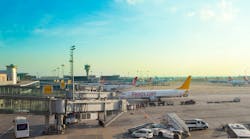Aircraft ground handling safety performance depends very much on what aircraft ground handling companies can do by themselves to improve their operational status quo.
In the remittal of individual service providers, there are many initiatives that can be implemented and other initiatives that ground handling companies worldwide are already implementing. These include the delivery of more effective forms of training, the adoption of common industry operational standards, the analysis of safety reports to identify operational safety issues and the development of the soft skills of operatives to improve the quality of the ramp as a work environment.
Yet, ground handling safety performance also depends on factors that ground handling companies do not influence directly, and one of these is airport design. In this month’s regional update on aircraft ground handling in the Asia-Pacific region, we will look at some infrastructural developments that are going on at many airports in the Asia-Pacific region to cope with the booming aviation industry and specifically with how the aircraft ground handling infrastructure is being catered for.
One of the main design criteria that airports in the Asia-Pacific region are following is an attempt to prevent the constraints that exist at many older large airports and contribute to make ground damage more likely, such as close stands.
“Hong Kong International Airport (HKIA) is committed to upholding high standards in operational safety. To achieve this, we strictly follow all aviation safety regulations and procedures, which cover all parts of HKIA’s operations on the airfield and on the apron. Airport design should include the early installation of infrastructure that encourages ground equipment pooling amongst ground handling agents. For example, provision of charging units at parking stands to facilitate electric ground equipment pooling will significantly reduce the ramp vehicular and equipment traffic and contribute to a greener airport. Meanwhile, the designs of HKIA not only consider the ICAO requirements, but also the flexibility to cater for different new aircraft types such as A380, B747-8, A350 and B787,” a spokesperson for HKIA says.
“For example, in the Midfield Concourse, which has been fully operational since March 2016, sufficient space is provided at each parking stand for a wide range of aircraft types and also for equipment manoeuvring and aircraft servicing. There are also strict and long standing guidelines for operators to observe when manoeuvring their ground service equipment to ensure the safety.”
HKIA’s Midfield Concourse is located west of Terminal 1 between the two existing runways and it has an area of 410,000 square meters. The Midfield Concourse has the capacity to serve an additional 10 million passengers every year. With an area of 105,000 square meters, it provides 20 parking stands and connects with Terminal 1 via an extension of the automated people mover system.
HKIA also aims to build a third runway to handle future traffic demands estimated at 102 million passengers, 8.9 million tons of cargo and 607,000 aircraft movements per year by 2030. The project will see the reclamation of approximately 650 hectares of land north of the existing airport island, bounded by approximately 13.4 km of seawall.
“The safety and security of staff, stakeholders and infrastructure is Perth Airport’s top priority. This has resulted in the implementation of ground support activities that create and maintain a safe environment on Perth Airport operated aprons. New aircraft stands have been designed to alleviate the risk of damage to aircrafts and ground support equipment (GSE). They include fixed ground power units and pre-conditioned air systems which are underslung on aerobridges to reduce ground-based equipment requirements on bays. The stands adhere to International Civil Aviation Organization and Civil Aviation Safety Authority Manual of Standards Part 139 clearance standards. By adhering to these standards, Perth Airport has the necessary space to store GSE that is required to service all aircraft types. Apron drive aerobridges also facilitate the efficient use of space at the bay,” according to a spokesperson for Perth Airport, which is the fourth largest domestic and international airport in Australia and is serviced by more than 30 international, domestic and regional airlines. In FY16, 13.8 million passengers passed through Perth Airport, with this figure set to rise to 28.5 million by 2034.
New Zealand’s Auckland Airport also takes the airport design issue very seriously.
“The approach varies greatly as to how to remove these constraints, and it includes predominantly a mixture of innovation, IT and infrastructure development as well as changes in operational practice. We are seeing a significant growth in the adoption of technology such as common use self-service check-in to relieve the footprint of check-in development and enhance the passengers experience at the same time, allowing operational resources to be refocussed on customer centric activities,” says Darrell Abbott, Auckland Airport aeronautical planning and performance manager.
Auckland Airport’s 30-year vision is to build a world-class airport that supports airlines and aviation-related businesses to be economically successful and to boost Auckland’s and New Zealand’s economies. This vision foresees the building of a second runway.
In airport design, efforts are being committed to avoid a mixed aircraft and GSE traffic on the apron, e.g. with lanes for ground support vehicles that do not cross taxiways. This is a key consideration of the future proofed design for Auckland Airport, according to Abbott.
“Taxiway crossings should be avoided to prevent conflict between aircraft and ground equipment. If appropriate, traffic lanes that underpass taxiways should be considered to facilitate vehicular and equipment traffic between aprons. For example, there are cross-field taxiways between the Midfield Concourse and passenger apron at HKIA. A tunnel under the taxiways is therefore built for airside vehicles and ground equipment,” the spokesperson for HKIA says.
“Through regular interaction with stakeholders, Perth Airport has a thorough understanding of the risks associated with GSE and aircraft servicing. These risks are always considered by operational and planning teams when designing or reconfiguring aprons. Where practical, the interaction between vehicles and aircraft is minimized through the use of apron marked roadways,” the spokesperson for Perth Airport says. “New aprons are designed with a preference for head of stand roadways, a design which has been incorporated in Perth Airport’s planned new International Terminal. Perth Airport also imposes strict speed limits and minimum distances from aircraft and fueling equipment. In addition, Perth Airport has an advanced and robust Airside Driving Program to prevent aircraft damage on the apron and most importantly, ensure the safety of all individuals. The program is undertaken by every person who drives a vehicle airside and is complemented by stringent road rules and safety promotions.”
Newer aircraft stands are being developed with fixed ground support installations that reduce GSE movements around aircraft and thus the likelihood of damage.
“Auckland Airport is very proud to be one of the few airports in the world to offer its Boeing 787-900 customers the capability to utilize mains power, instead of their APUs, to run their aircraft whilst on stand and to actually run up their engines,” says Abbott.
Fixed ground power system and pre-conditioned air systems are also provided at parking stands at HKIA to reduce the need of corresponding ground equipment to move around aircraft.
Fixed ground support installations surely have a safety benefit but may require a more significant capital expenditure and longer time horizons to reach break-even.
“The improvement in ramp traffic efficiency in turn enhances customer experience such as quicker baggage delivery. Besides, it contributes a lot to a greener airport by significant reduction of carbon emission from the aircraft auxiliary power units, ground power units and air-condition units powered by fossil fuel,” the spokesperson for HKIA says.
“The benefits are more than financial from an airport’s perspective and safety is our primary concern, not only for passengers but our entire airport community. There are environmental benefits, and we have always seen a commercial benefit, not necessarily in direct revenue but in reducing the need for further future capital expenditure,” says Abbott.
Other considerations that should drive airport design to make the system more resilient, namely less prone to aircraft damage on the apron are a focus on the behavior and operational procedures of system management is paramount. A world-class operation realizes less risk, concludes Abbott.




